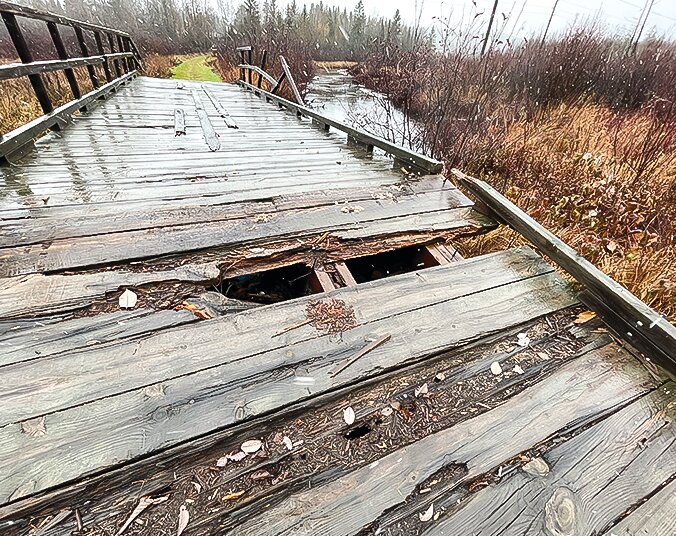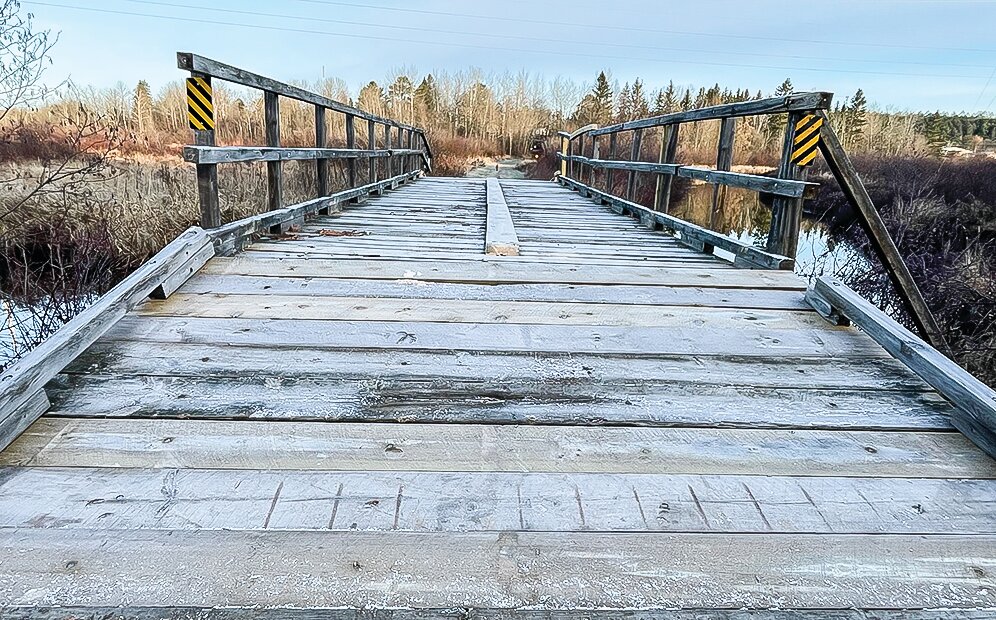Support the Timberjay by making a donation.
Aging bridges pose challenge for clubs, DNR
REGIONAL— The state of Minnesota, with help from local clubs, maintains more than 22,000 miles of snowmobile trails across the state, and that means countless bridges that cross streams, …
This item is available in full to subscribers.
Attention subscribers
To continue reading, you will need to either log in to your subscriber account, or purchase a new subscription.
If you are a current print subscriber, you can set up a free website account and connect your subscription to it by clicking here.
If you are a digital subscriber with an active, online-only subscription then you already have an account here. Just reset your password if you've not yet logged in to your account on this new site.
Otherwise, click here to view your options for subscribing.
Please log in to continue |
Aging bridges pose challenge for clubs, DNR
REGIONAL— The state of Minnesota, with help from local clubs, maintains more than 22,000 miles of snowmobile trails across the state, and that means countless bridges that cross streams, ditches, and wetlands, all requiring maintenance and eventual replacement.
And with much of the state’s trail infrastructure dating back to the 1980s and 90s, many of those bridges are coming due for major repairs or replacement— and the cost of that work is a lot higher than it was in the past.
And that means some bridges may go without needed repairs for longer than would otherwise be the case. A typical example can be found right in Tower, where the Iron Ore Trail cuts south from the Taconite Trail. A small wooden bridge provides access across the East Two River and it’s used by snowmobilers as well as hikers accessing the Ancient Cedars Trail.
But the condition of the bridge deteriorated significantly over the past two years, with decking that had rotted and fallen away in places, and a wooden railing that has fallen into the river.
“We have a lot of bridges like that, a lot of homemade bridges from back in the day,” said Joe Majerus, area trails manager in the DNR’s Tower office.
While DNR trails staff made repairs to the bridge this past week, the situation helps to highlight the magnitude of the task of maintaining a vast trails infrastructure, most of which is maintained by private snowmobile clubs.
Majerus said he’d gotten a couple inquiries about the condition of the bridge in question, and a call from this reporter was another reminder that the bridge was in serious need of repair. Majerus had said his staff would make the needed repairs by the time the snowmobile season gets officially underway on Dec. 1— a promise that he fulfilled just ahead of Thanksgiving.
But assessing the condition and safety of hundreds of bridges across the state, and funding needed repairs, replacement, and upgrades on bridges that may not be as easily accessible as the bridge in Tower, is a challenging and often complicated balancing act. “We’ve got a backlog of aging infrastructure that we’re continually trying to keep up with,” said Chuck Carpenter, the DNR’s parks and trails regional manager based in Grand Rapids.
Carpenter said safety is the DNR’s first priority and he said engineers are supposed to inspect every state-managed bridge on a three-to-five-year cycle.
How many bridges are we talking about?
“We don’t know how many bridges are in the system,” said Wade Miller, state trail and snowmobile program consultant with the DNR, based in St. Paul. “There are a lot of bridges within the snowmobile system on private and public lands. The DNR owns, inspects, and maintains 550 of them. A total of 442 are snowmobile bridges.” According to Miller, when the DNR inventoried all the snowmobile trails in the state back in 2009, it identified its own bridges, but has inventoried the many grant-in-aid bridges not on state lands. “I couldn’t even give you a guess how many the clubs maintain,” he added. Determining that number “hasn’t been a priority,” he said, because landownership changes, trail permissions terminate and reroutes are identified.
Complicating that question for the DNR is the fact that the agency isn’t responsible for most of the bridges in the system. Out of the 22,000 miles of snowmobile trails in the state, the DNR actually grooms about 1,200 miles. The vast majority of trails in the state, about 21,500 miles, are maintained by local snowmobile clubs who fund their operations through a combination of local fundraising and state grant-in-aid dollars that pays for trail maintenance and grooming. In most cases, as part of their grant-in-aid contracts, clubs agree to take responsibility for maintaining their own bridges.
“They need to make sure it can support the weight,” of things like snowmobiles and groomers, said Miller. “They need to inspect their own bridges.”
In other cases, where bridges cross existing roads, it’s up to the local road authority to inspect and maintain their bridges to a safe standard in most cases. Bridges located on county and federal lands are typically the responsibility of agencies like the U.S. Forest Service to maintain. That’s not always the case since underlying maintenance agreements are sometimes made that place the responsibility for bridge maintenance with another entity. What’s more, many of the snowmobile trail bridges are on private land and it can be up to the landowner, depending on the agreements in place, to ensure their bridge is safe.
And many of the bridges are beginning to show their age. Much of the existing snowmobile trail network was established back in the 1970s, which means many of the mostly wooden bridges that provide road and water crossings are anywhere from 35-45 years old.
“Some of them are pretty scary,” said Ron Potter, who retired from DNR trails several years ago and has worked mostly on ATV trail development since. “A lot of times, when the clubs built those bridges years ago, they used whatever they could find. Old telephone poles, and things like that. One we replaced on the Birch River was an old railroad flat car,” he said. Some clubs have used old railroad trestle bridges, sometimes hundreds of feet long, that are among the scariest, and oldest, bridges on the system, noted Potter.
Ongoing maintenance, repairs, and replacement is key to maintaining this critical trail infrastructure, but Miller notes that the cost of doing that work has increased dramatically.
A 15-ton bridge, which is the standard for statutorily authorized state trails, such the Taconite or Arrowhead trails, is a big investment these days. “They can cost from $200,000 up to a million dollars,” said Miller.
Those investments can improve the efficiency of grooming operations, particularly as older bridges, such as the Taconite Trail’s arched metal bridge over the Pike River, are replaced. That’s a five-ton bridge that DNR groomers quit using several years ago as a result of its unnerving tendency to bounce noticeably as the grooming rigs passed over. Majerus said that bridge is scheduled for replacement soon.
The Pike River bridge is something of an exception given its length and height and metal construction. Majerus said most of the bridges are like the one crossing the East Two River along the Iron Ore Trail— homemade, wooden, and well past their prime.
While maintaining a high standard for the trail system’s bridges might be a laudable goal, Miller said the impact could be significant. “If every bridge in the state had to meet the same specs, there’s not the money anywhere to meet that requirement,” said Miller. “If you think of all the water in Minnesota, we would lose a lot of trails.”
At the local level, Majerus said his staff is “slowly chipping away” at the backlog of needed repairs on bridges in the Tower work area as funds are available and notes “some bridges are worse than others.”
Keeping track of what bridges are most in need, and determining which of any number of entities might be responsible for maintaining them isn’t always easy, acknowledges Miller.
“In some cases, it’s probably unclear,” said Miller and can require locating old agreements that might date back decades.
Funding variable
While local snowmobile clubs are responsible for maintenance and grooming of their trails under their grant-in-aid funding, money for significant bridge repairs or replacement generally comes from separate DNR project grants. Demand for those funds appears to be on the rise. Miller said in the past, the DNR received few applications for bridge projects from local clubs, but the agency received 12 applications this year and were only able to fund half of them, at a little over a million dollars combined.
The funding available for that work, like the funding available for grooming and other trail work can be highly variable, depending on winter conditions.
The funds that go out to clubs are raised from two primary sources, snowmobile registration fees and a small portion of the state’s gas tax that is supposed to reflect the percentage of fuel used by snowmobilers. Gas tax dollars have been slowly declining, notes Miller, as more drivers turn to electric or hybrid vehicles that use little or no gasoline. And he said the amount of funding generated by registration fees is highly dependent on snow conditions. In winters when little snow falls, registration fees can drop significantly.
On average, said Miller, the DNR generates a little over $13 million annually to fund grooming and maintenance of the entire trail system, which highlights the challenges when replacing a single bridge can cost a million dollars.
“The snowmobile account can’t sustain all the bridges by itself,” he notes.
Fortunately, notes Potter, many clubs have learned to tap other sources of funding. When the Ely Igloos decided recently to replace an old bridge over the Kawishiwi River, he said they reached out to Lake County to put in for state bonding dollars. The Babbitt area club tapped funds from Iron Range Resources and Rehabilitation, some ATV-dedicated, and a federal recreation funding program to replace the old rail car bridge over the Birch River which serves both snowmobiles and ATVs. Potter said tapping such funding sources are critical since the available from the snowmobile account isn’t up the need.









